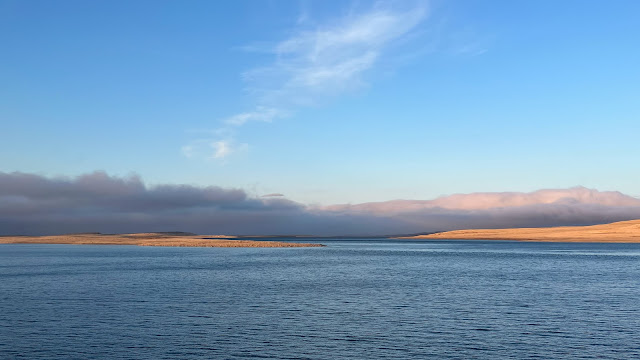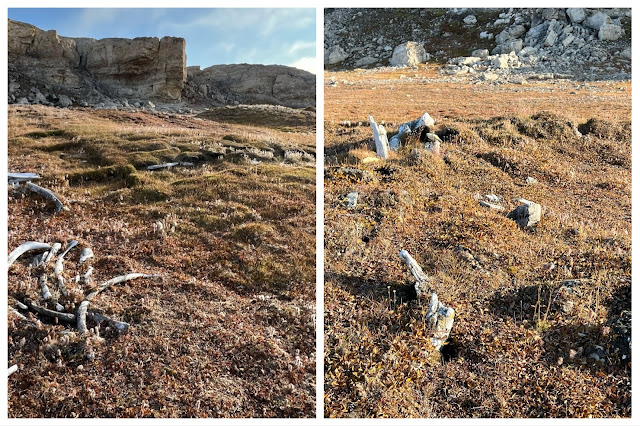 |
| Stunning flat landscape of Hazard Inlet |
My head is spinning from the marvellous vistas sliding past our eyes. Travelling through this region of the high Canadian Arctic has been more exciting than I imagined it would be. This morning, after a very early morning reconnaissance run, our leader Ashley took us into Hazard Inlet, a shallow, quiet but very treacherous inlet few have ventured into - except for the Inuits over many 100s of years. We had only a short window of time to get in and out before the tide made navigation dangerous. The area, Qariaraqyuk, was home to Inuit people about 500 to 800 years ago. It seems that they abandoned the area around the time of the Northern Little Ice Age. There is some debate over dates but it occurred around C14 until the mid-C19 or thereabouts (this came after the Medieval Warm Period - interesting pattern!). Dates aside, increasing cold and sea ice probably pushed these people further south. Before that time, it was a large settlement of 300-400 people who survived on Bowhead whaling.
 |
| It was quite a long ride into the Inlet as the waters were too shallow for our ship |
 |
| A very tranquil place |
 |
| The Inuit settlement site. Their burial sites are along these cliffs |
 |
| Picking our way across a stony beach and slippery seaweed |
We stumbled across tiers of gravel then a stretch of delightfully squishy tundra (like walking on a waterbed) to reach the remains of sod houses, whale bones and cliffs containing burial sites. Absolutely fascinating. The houses were made of sod with whale bones forming the roofs and support walls - these had been disturbed.
 |
| The backbone of a Bowhead whale |
 |
| The bones were used to support the walls and roof of sod houses |
Our archaeologist, Professor Lisa Rankin, was ecstatic that we were able to land there as she had never visited this site and had been hoping to return to do more work. Sadly another archaeologist had visited the site some years early and had disturbed the bones in an attempt to do a bone count. Why? One can only wonder as it seriously impacted the archaeological trace. Good intentions perhaps or ignorance, but a bad outcome. Because of the tides, we only had a short time there so I of course was snapping crazily to capture as much as I could. Achaeological remains notwithstanding, for me there was the added bonus of looking at the tundra plants - mosses, lichens, grasses, willows, (including quite a few I couldn’t identify) and great banks of seaweed washed up on the beach. Despite this being a ‘desert’, it is quite a fertile area.
 |
| Jewel Lichen |
 |
| A stray clump of qiviut, evidence that musk ox roam here. |
 |
Banks of Sphagnum and/or Peat Moss. Bottom picture shows the cracks that develop
in the land with repeated freezing and thawing |
 |
| Quite a selection which I struggled to identify but which caught my attention - endless textures |
 |
| L: Tufted Saxifrage, Top R: Mountain Avens/Arctic Dryad, Bottom R: fluffy seeds of Arctic Willow (the Inuit use this fluff and that of Cotton Grass as wicks for their oils lamps.) |
 |
| The arrow points to Bellot Strait where we sailed this afternoon |
That afternoon we sailed through the Bellot Strait, a narrow seapassage which passes the northernmost point of the 14,000 km long American continent. We saw narwhal and musk ox amid driving snow flurries.
 |
| The northernmost point of the North American Continent |
One barely has time to draw breath before we are presented with more fascinating 'things'. Before dinner, our Inuit cultural advisors gave a talk on the Inuit names and uses of the local plants - I was all ears as you can imagine. Eli Qaggasiq-Tagtu our young Inuit cultural ambassador has made a date with me to collect berries once we get to Alaska (of course we weren't allowed to land but didn't know that at the time).
 |
| Our voyage to date |




















These photos are very evocative, as I spent a summer living here in the early 90's. Your story of the site is slightly garbled, however; most of the house sites at the bottom of the cliff were thoroughly excavated, not 'disturbed to do a bone count'. What you are seeing is the backfilled excavation sites, with erosion revealing the many bones that were left on site. The excavation has been published - look up the formal name of the site, Pa-Js 2, for reports that will provide accurate information about the site and the work that we did there.
ReplyDelete